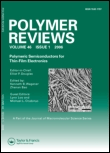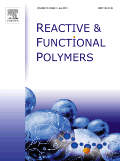
Polymers
Scope & Guideline
Unveiling the potential of polymers for industrial progress.
Introduction
Aims and Scopes
- Synthesis and Characterization of Polymers:
Research focused on developing new polymerization techniques, including the use of biopolymers and sustainable practices, and the characterization of polymers using advanced techniques. - Polymer Composites and Nanocomposites:
Investigation into the integration of nanomaterials and natural fibers into polymer matrices to enhance mechanical, thermal, and electrical properties. - Biodegradable and Eco-friendly Polymers:
Exploration of biodegradable polymers and their applications in sustainable packaging, biomedical applications, and environmental remediation. - Polymer Processing Techniques:
Studies on various polymer processing methods such as 3D printing, electrospinning, and injection molding, focusing on optimizing parameters for improved material performance. - Functional Polymers for Biomedical Applications:
Research into polymers designed for medical use, including drug delivery systems, tissue engineering scaffolds, and biocompatible materials. - Applications in Environmental Science:
Exploration of polymers in wastewater treatment, pollution control, and as materials for energy storage and conversion technologies. - Smart and Responsive Polymers:
Development of polymers with stimuli-responsive properties for applications in sensors, actuators, and other advanced materials.
Trending and Emerging
- Sustainable and Bio-Based Polymers:
Increasing focus on polymers derived from renewable resources and those designed to be biodegradable, aligning with global sustainability goals. - Advanced 3D Printing Techniques:
Emerging research in additive manufacturing highlights innovative methods and materials, such as biopolymers and composite filaments, enhancing the functionality and application of 3D-printed structures. - Smart Polymers and Responsive Materials:
Growing interest in polymers that change properties in response to environmental stimuli, paving the way for applications in sensors, drug delivery systems, and soft robotics. - Nanotechnology in Polymer Science:
Exploration of nanocomposites and the incorporation of nanomaterials into polymers to significantly enhance their properties and functionalities. - Multifunctional Polymer Systems:
Research into polymer systems that serve multiple functions, such as antimicrobial properties, self-healing capabilities, and enhanced mechanical performance. - Integration of Machine Learning in Polymer Research:
Utilization of machine learning techniques to predict polymer behavior, optimize synthesis processes, and analyze material properties, reflecting the trend towards data-driven research. - Polymer-Based Energy Storage and Conversion:
Emerging studies focus on polymers used in batteries, supercapacitors, and fuel cells, highlighting their potential in enhancing energy efficiency and sustainability.
Declining or Waning
- Conventional Polymer Processing Techniques:
Research on traditional methods such as simple extrusion or molding without innovative adaptations is becoming less frequent as the field advances towards more sophisticated processing techniques. - Focus on Non-Biodegradable Plastics:
There is a noticeable decline in studies centered around non-biodegradable plastics, as the scientific community increasingly emphasizes sustainability and the development of biodegradable alternatives. - Basic Polymer Chemistry:
Research focusing solely on fundamental polymer chemistry without practical applications or advancements in technology is seeing reduced interest in favor of applied and interdisciplinary studies. - Single-Use Plastic Applications:
Studies related to single-use plastics are declining as the emphasis on sustainability and environmental impact grows, leading to a preference for reusable or biodegradable materials.
Similar Journals

EUROPEAN POLYMER JOURNAL
Exploring the Frontiers of Polymer ResearchEUROPEAN POLYMER JOURNAL is a leading academic journal published by PERGAMON-ELSEVIER SCIENCE LTD, dedicated to advancing the field of polymer science and engineering. With a distinguished history since 1965, this journal serves as a critical platform for researchers to disseminate high-quality research findings within a broad scope that encompasses materials chemistry, organic chemistry, and physics. The journal boasts an impressive Q1 category ranking in multiple fields, including Materials Chemistry, Organic Chemistry, and Polymers and Plastics, placing it in the top tier of academic journals worldwide. Its standing is further reinforced by its high citation metrics, with ranks such as #16 in Organic Chemistry and #20 in Polymers and Plastics, reflecting its significant contribution to the advancement of knowledge and innovation in these areas. Although currently not available as an open-access journal, it provides subscribers with in-depth studies, reviews, and insights relevant to both academia and industry. Researchers, professionals, and students alike will find invaluable information and emerging trends in polymer research, making the EUROPEAN POLYMER JOURNAL an essential resource for staying at the forefront of this dynamic and evolving field.

Polymer Reviews
Leading the dialogue in materials engineering.Polymer Reviews, published by Taylor & Francis Inc, is an esteemed journal dedicated to the intricate and evolving field of polymer science. With its ISSN 1558-3724 and E-ISSN 1558-3716, the journal has established a significant presence among researchers and practitioners alike, evidenced by its impressive categorization in the Q1 quartiles across multiple disciplines, including Biomedical Engineering, Materials Chemistry, and Renewable Energy. Since its inception in 2006 and continuing through 2024, Polymer Reviews has consistently aimed to advance the knowledge base of polymer applications and innovations, providing a platform for comprehensive review articles that stimulate further research and inspire practical solutions. The journal, ranking within the top percentile across several Scopus categories, underscores its impact and relevance in a rapidly developing scientific landscape. Though not an open-access journal, it remains a vital resource for those invested in the future of materials science and engineering.

POLYMER INTERNATIONAL
Elevating Knowledge in the World of PolymersPOLYMER INTERNATIONAL is a leading journal in the field of polymer science, published by Wiley, one of the most esteemed scholarly publishers. With an ISSN of 0959-8103 and an E-ISSN of 1097-0126, this journal has been a pivotal platform for researchers since its inception in 1991, now extending its coverage until 2024. The journal boasts a commendable standing in various scientific domains, achieving a Q2 quartile ranking in Materials Chemistry, Organic Chemistry, and Polymers and Plastics as of 2023. Additionally, it holds impressive Scopus ranks, including Rank #47 in Organic Chemistry and Rank #40 in Polymers and Plastics, placing it within the top percentiles of its categories. Researchers, professionals, and students alike can benefit from its rich array of articles that contribute to the understanding and advancement of polymer technology and materials science. Although not an open access journal, POLYMER INTERNATIONAL remains crucial for disseminating high-quality research that drives innovation and development within the field.

E-POLYMERS
Fostering Collaboration in the Evolving World of Materials ScienceE-Polymers, an esteemed journal published by De Gruyter Poland Sp. z o.o., serves as a vital platform for advancing knowledge in the fields of chemical engineering, polymer science, and theoretical chemistry. With its Open Access policy since 2019, researchers from around the globe can freely access and disseminate groundbreaking findings that span the convergence of diverse disciplines, making it an indispensable resource for both academia and industry. The journal is recognized for its significant impact, reflected in its Q2 ranking in Chemical Engineering, Physical and Theoretical Chemistry, and Polymers and Plastics categories in 2023. Its impressive Scopus rankings further solidify its position, showcasing a percentile rank of 70th and above across major categories. With a publication history extending from 2001 to 2024, E-Polymers continually addresses pressing challenges within the polymer research community, fostering innovation and collaboration among researchers, professionals, and students eager to contribute to the evolving landscape of materials science.

POLYMER
Driving Discoveries in the World of PolymersPOLYMER, an esteemed journal published by Elsevier Science Ltd, stands at the forefront of polymer science, presenting cutting-edge research that encompasses the realms of Materials Chemistry, Organic Chemistry, and Polymers and Plastics. With a remarkable impact factor reflecting its significance in the academic community, POLYMER has been a vital resource since its inception in 1960, contributing to a converged body of knowledge through to 2024. Rated Q1 in all relevant categories as of 2023, and boasting impressive Scopus rankings, this journal not only facilitates advanced discussions in polymer synthesis, characterization, and applications but also serves as a critical platform for collaborative research among scholars, professionals, and students. While it offers content primarily via subscription, POLYMER remains dedicated to fostering innovation and excellence in the field, making it an essential read for anyone passionate about polymer science.

REACTIVE & FUNCTIONAL POLYMERS
Pioneering Research for a Sustainable Polymer FutureREACTIVE & FUNCTIONAL POLYMERS, published by Elsevier, is a leading journal in the field of polymer science, focusing on the innovative development and application of reactive and functional polymers. With an impressive impact demonstrated through its classification in various prestigious categories, including Q1 rankings in Chemical Engineering, Chemistry, and Materials Chemistry, this journal serves as an essential resource for researchers and professionals seeking to explore the latest advances in polymer research. With a broad scope that encompasses topics from biochemistry to environmental chemistry, and a convergence of significant findings from 1995 to 2024, REACTIVE & FUNCTIONAL POLYMERS fosters academic dialogue and collaboration among scientists. The journal also features Open Access options, ensuring that groundbreaking research is readily available to a global audience. By consistently publishing high-quality articles, it not only enriches the scientific community but also drives innovation across various industries reliant on polymer technologies.

MACROMOLECULAR RESEARCH
Connecting Researchers in the World of PolymersMACROMOLECULAR RESEARCH, published by the POLYMER SOC KOREA, is a premier journal dedicated to advancing the field of macromolecular science and polymer engineering. With its ISSN 1598-5032 and E-ISSN 2092-7673, this journal has emerged as a vital platform for researchers and professionals interested in the application and development of polymers across various domains. Based in South Korea and operating as an open-access resource since its inception in 2002, MACROMOLECULAR RESEARCH consistently ranks in the Q2 category across diverse fields such as Chemical Engineering, Materials Chemistry, and Organic Chemistry as per the latest 2023 metrics. Notably, it is recognized for its substantial contributions to polymery science, increasing its visibility and impact in global research. By providing a forum for original research articles, reviews, and innovative methodologies, this journal aims to foster collaboration and knowledge sharing among scientists, engineers, and students alike. Join a community that is at the forefront of polymer research by exploring the wealth of resources and cutting-edge studies featured in MACROMOLECULAR RESEARCH.

ACS Applied Polymer Materials
Innovating Materials, Transforming ApplicationsACS Applied Polymer Materials is a prestigious journal published by the American Chemical Society, specifically tailored for the dynamic fields of Organic Chemistry, Polymers and Plastics, and Process Chemistry and Technology. With its ISSN 2637-6105, the journal has rapidly established itself within the academic community, achieving a distinguished Q1 quartile ranking across multiple categories in 2023. This places it among the top-tier journals globally, reinforcing its critical role in disseminating groundbreaking research and innovation in polymer science. The journal is known for its rigorous peer-review process and publishes high-quality articles that are pivotal for researchers, professionals, and students eager to advance knowledge in polymer materials and their applications. Positioned to cover converging themes from 2019 through 2024, ACS Applied Polymer Materials embraces a wide scope of studies, from fundamental chemistry to practical engineering applications, thereby fostering significant advancements in material science. While it offers traditional access options, the journal's impact is reflected in its impressive rankings within Scopus, indicating its relevance and influence in the chemical engineering domain. Join the global community of innovators and discover the latest insights that continue to shape the landscape of applied polymer research.

JOURNAL OF POLYMER RESEARCH
Illuminating Innovations in Materials ChemistryJOURNAL OF POLYMER RESEARCH is a leading peer-reviewed journal published by SPRINGER, specializing in the dynamic fields of polymer science, materials chemistry, and organic chemistry. Operating since 1994, this esteemed journal has consistently delivered high-quality research articles that illuminate the latest advancements and innovations in polymer technology. With an increasing impact factor and placed in the Q2 category for both Materials Chemistry and Polymers and Plastics, it stands as a valuable resource for researchers, professionals, and students seeking cutting-edge knowledge in these areas. The journal is indexed in Scopus, highlighting its significance in the academic community, with notable rankings in Materials Science and Organic Chemistry. While it does not currently offer open access options, the meticulous selection of research and thorough peer-review process ensures each article's contribution to the field is both robust and impactful. Researchers aiming to expand their understanding and engage with pioneering studies will find JOURNAL OF POLYMER RESEARCH an indispensable platform.

Express Polymer Letters
Unleashing Innovation in Polymer ResearchExpress Polymer Letters is a leading open-access journal published by BUDAPEST UNIVERSITY OF TECHNOLOGY AND ECONOMICS, focusing on the fast-paced realm of polymer science and engineering. With a broad scope that encompasses the interdisciplinary fields of Chemical Engineering, Materials Chemistry, and Organic Chemistry, the journal serves as a crucial platform for researchers and professionals dedicated to advancing knowledge and innovation in polymer-related disciplines. Since its inception in 2007, it has consistently provided high-quality, peer-reviewed research and has achieved a respectable impact within various categories, evidenced by its Q2 quartile rankings across multiple Scopus categories and its competitive standings in the field. The journal's dedication to open access ensures that research is widely disseminated, promoting transparency and collaboration within the academic community. Positioned to converge into the future, Express Polymer Letters remains an essential resource for cutting-edge studies and developments, with an anticipated convergence period extending through 2024.